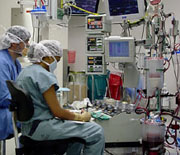Sometimes cardiovascular surgeons can operate on the heart when it is beating, but often they need to have it still. To maintain blood flow to the body’s tissues during operations when the heart needs to be stopped, surgeons call on perfusion technologists (often referred to as the “pump team”).
Perfusionists are vital members of the cardiovascular surgical team because they are responsible for running the heart-lung (cardiopulmonary bypass) machine. The heart-lung machine diverts blood away from the heart and lungs, adds oxygen to the blood, then returns the blood to the body—all without the blood having to go through the heart. During surgery, perfusionists use the heart-lung machine to maintain blood flow to the body’s tissues and regulate levels of oxygen and carbon dioxide in the blood. Perfusionists are also responsible for measuring selected laboratory values (such as blood cell count) and monitoring circulation. Under the direction of the anesthesiologist and surgeon, perfusionists may also administer medicines through the cardiopulmonary bypass circuit.
Because perfusion technologists are needed for most open heart operations, they are in great demand. To meet this need, the Texas Heart Institute created the School of Perfusion Technology in 1972. The Institute’s school is the largest perfusion technology training program in the country.
With the school leading the way, the Texas Heart Institute continues to advance the science of cardiopulmonary bypass and improve the care of patients in the operating room.
|
Heart-Lung Machine Innovations
|
|
The first heart-lung machines used in the mid-50s had 2 permanent parts: a breathing apparatus (called an oxygenator) and a pump. By the end of 1956, Dr. Cooley had used a heart-lung machine for nearly 100 operations. However, cleaning the oxygenator and replacing the plastic tubing was difficult and costly. Dr. Cooley decided that the heart-lung machine could be simpler and more efficient with disposable parts, which didn’t need to be sterilized. Within 15 years, disposable oxygenators were available in operating rooms throughout the country. Today, almost all parts of the heart-lung machine are disposable, open heart surgery is safer, and surgeons can treat many more patients.
|
Updated August 2016



